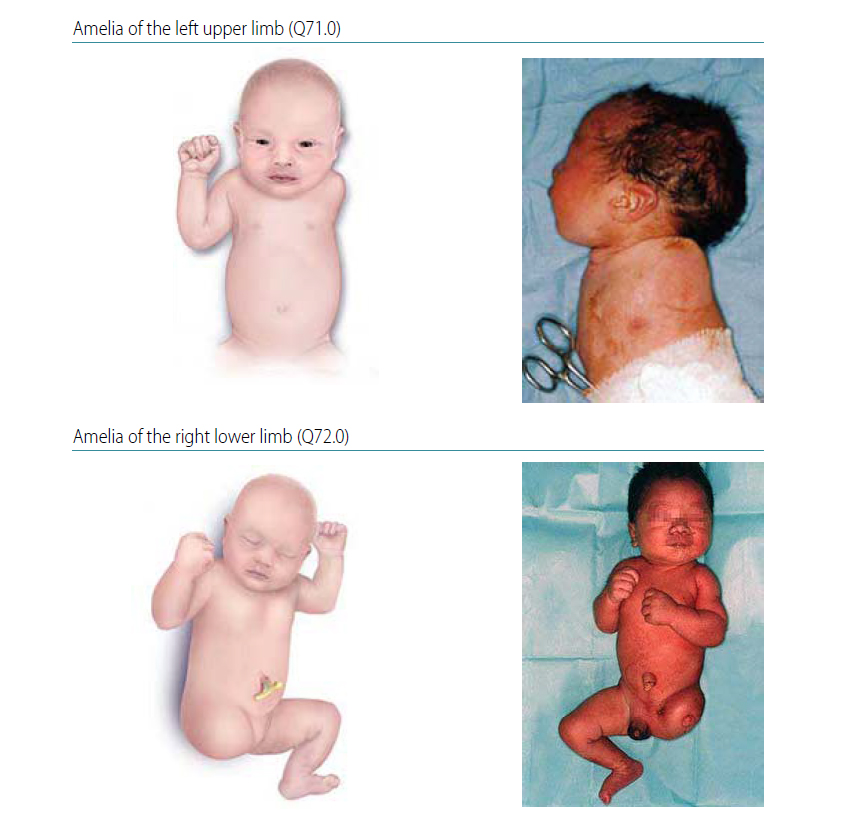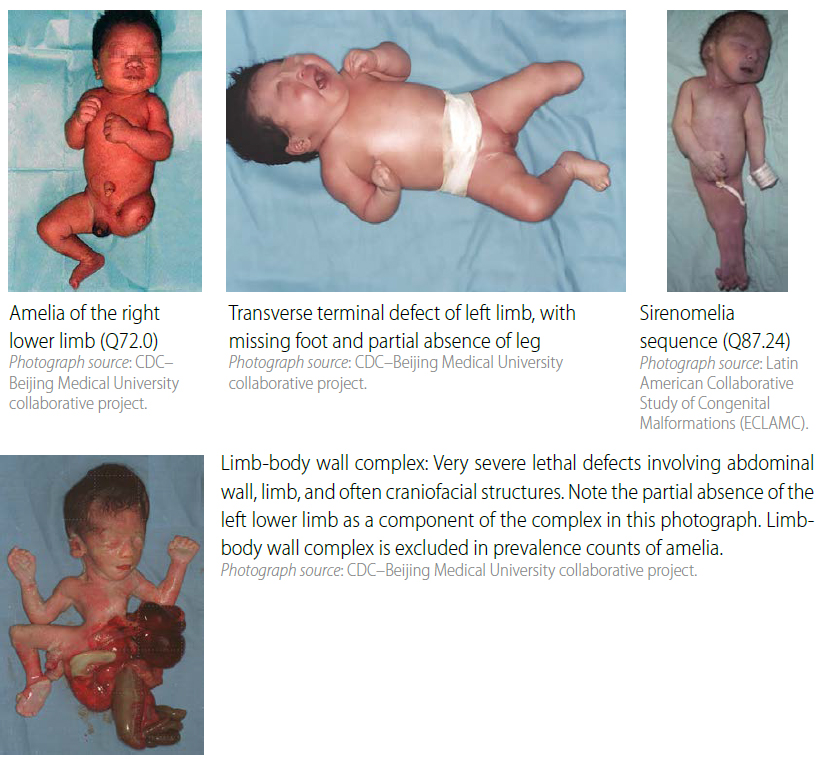4.9c Limb Deficiency Amelia (Q71.0, Q72.0, Q73.0)
‹View Table of Contents
Limb Deficiency Amelia (Q71.0, Q72.0, Q73.0)
Amelia is a congenital anomaly characterized by the complete absence of one or more limbs (see Fig. 4.36).
Fig. 4.36. Amelia

Photograph source: CDC–Beijing Medical University collaborative project.
Relevant ICD-10 codes
Q71.0 Congenital complete absence of upper limb(s); amelia of upper limb
Q72.0 Congenital complete absence of lower limb(s); amelia of lower limb
Q73.0 Congenital absence of unspecified limb(s); amelia NOS
Note: Avoid using the generic Q71, Q72 or Q73 code for amelia. These generic codes include other limb deficiencies. Q73.0 is used for
amelia when the limb (upper or lower) is not specified. The use of the code Q73.0 should be minimized.
Diagnosis
Prenatal. Amelia can be diagnosed or strongly suspected prenatally. However, it might be missed. The distinction from other limb deficiencies is difficult and error-prone in prenatal diagnosis. For this reason, a prenatal diagnosis should always be confirmed postnatally.
When this is not possible (e.g. termination of pregnancy or unexamined fetal death), the programme should have criteria in place to determine whether to accept or not accept a case based solely on prenatal data.
Postnatal. The newborn examination confirms the diagnosis of amelia and distinguishes it from other limb deficiencies (e.g.terminal transverse defects) and sirenomelia. Imaging (radiographs) might provide further diagnostic information in cases that are less clear.
Clinical and epidemiologic notes
Distinguishing amelia from other limb deficiencies is important because these conditions have different causes and associated anomalies. With careful clinical and radiological examination, the diagnosis of amelia is usually straightforward. Radiology is strongly recommended to confirm the absence of the proximal segment of the humerus or femur. In typical amelia, there is no bony limb structure.
In most cases of amelia, only one limb is absent, with each side being affected with approximately equal frequency. Upper limb amelia occurs slightly more often than lower limb amelia.
Amelia is often associated with other anomalies. The most frequent congenital anomalies seen with amelia are other types of musculoskeletal defects, as well as intestinal, renal and genital defects; oral clefts; cardiac septal defects; and anencephaly. Syndromes are uncommon in amelia, but do occur, including Roberts syndrome and thalidomide embryopathy.
Complex conditions potentially confused with amelia are sirenomelia and limb-body wall spectrum. Sirenomelia cases should not be included as amelia. In sirenomelia there is complete or partial fusion of lower limbs, variably associated with sacral defects, anal atresia, abnormal external genitalia and absence of kidneys.
Cases with limb-body wall complex defects should not be included as amelia. Limb-body wall spectrum defects include transverse terminal limb deficiencies, abdominal wall disruption, atypical exencephaly/encephalocele, atypical facial clefts, and at times, amniotic bands.
Amelia is very rare. The overall total prevalence of amelia ranges from 0.4 to 2.4 per 100 000 births. The prevalence of amelia among stillbirths is at least 30 times higher than that among live births.
Inclusions
Q71.0 Congenital complete absence of upper limb(s); amelia of upper limb
Q72.0 Congenital complete absence of lower limb(s); amelia of lower limb
Q73.0 Congenital absence of unspecified limb(s)
Exclusions
Q71.1 Congenital absence of upper arm and forearm with hand present
Phocomelia of upper limb
Q71.2 Congenital absence of both forearm and hand
Q71.3 Congenital absence of hand and finger(s)
Q72.1 Congenital absence of thigh and lower leg with foot present
Phocomelia of lower limb
Q71.30 Congenital absence of finger(s)
Q72.2 Congenital absence of both lower leg and foot
Q72.3 Congenital absence of foot and toe(s)
Q72.4 Longitudinal reduction defect of femur
Proximal femoral focal deficiency
Q72.30 Congenital absence or hypoplasia of toe(s) with remainder of foot intact
Q87.24 Sirenomelia
Q89.81 Limb-body wall complex
Q87.25 Thrombocytopenia absent radius syndrome
Related codes
Q86.82 Congenital malformations due to thalidomide
Checklist for high-quality reporting
| Amelia – Documentation Checklist |
Describe in detail (avoid using only the term “amelia”), including:
|
Suggested data quality indicators
| Category | Suggested Practices and Quality Indicators |
| Description and documentation | Review sample for documentation of key descriptors:
|
| Coding |
|
| Clinical classification |
|
| Prevalence |
|
| Key visuals | Distinguishing amelia from transverse limb deficiencies and sirenomelia (side-by-side comparison):
|
Table of Contents
- Chapter 4: Diagnosing and Coding Congenital Anomalies
- 4.1 List of Selected External and Internal Congenital Anomalies to Consider for Monitoring
- 4.2 Congenital Malformations of the Nervous System: Neural Tube Defects
- 4.2a Anencephaly
- 4.2b Craniorachischisis (Q00.1)
- 4.2c Iniencephaly (Q00.2)
- 4.2d Encephalocele (Q01.0–Q01.83, Q01.9)
- 4.2e Spina Bifida (Q05.0–Q05.9)
- 4.3 Congenital Anomalies of the Nervous System: Microcephaly
- 4.4 Congenital Malformations of the Ear
- 4.5a Overview Congenital Heart D: Prenatal Diagnosis and Postnatal Confirmation
- 4.5b Common Truncus (Q20.0)
- 4.5c Transposition of Great Arteries (Q20.3)
- 4.5d Tetralogy of Fallot
- 4.5e Pulmonary Valve Atresia (Q22.0)
- 4.5f Tricuspid Valve Atresia (Q22.4)
- 4.5g Hypoplastic Left Heart Syndrome (Q23.4)
- 4.5h Interrupted Aortic Arch (q25.21, Preferred; Also Q25.2, Q25.4)
- 4.6 Orofacial Clefts
- 4.7 Congenital Malformations of the Digestive System
- 4.8 Congenital Malformations of Genital Organs Hypospadias (Q54.0–Q54.9)
- 4.9a Congenital Malformations and Deformations of the Musculoskeletal System: Talipes Equinovarus (Q66.0)
- 4.9b Congenital Malformations and Deformations of the Musculoskeletal System: Limb Reduction Defects/Limb Deficiencies
- ›4.9c Limb Deficiency Amelia (Q71.0, Q72.0, Q73.0)
- 4.9d Limb Deficiency: Transverse Terminal (Q71.2, Q71.3, Q71.30, Q72.2, Q72.3, Q72.30)
- 4.9e Limb Deficiency: Transverse Intercalary (Q71.1, Q72.1, Q72.4)
- 4.9f Limb Deficiency: Longitudinal Preaxial (Tibia, Radius, First Ray) (Q71.31, Q71.4, Q72.31, Q72.5)
- 4.9g Limb Deficiency: Longitudinal Postaxial (Fibula, Ulna, Fifth Ray) (Q71.30, Q71.5, Q72.30, Q72.6)
- 4.9h Limb Deficiency: Longitudinal Axial Limb Deficiency – Split Hand and Foot (Q71.6, Q72.7)
- 4.10 Abdominal Wall Defects
- 4.11 Chromosomal Abnormalities
